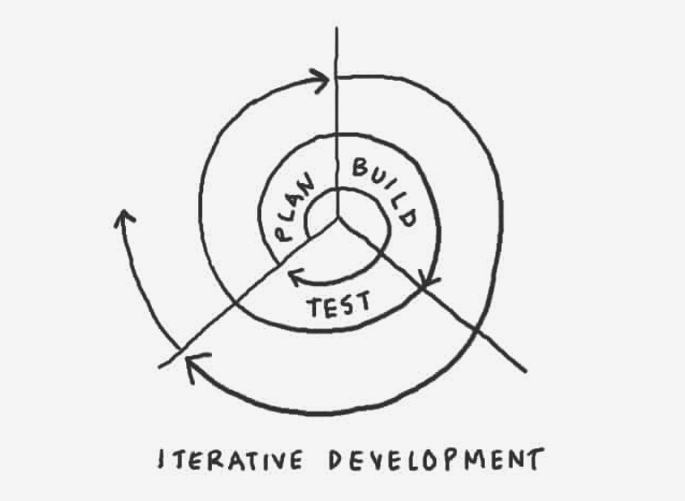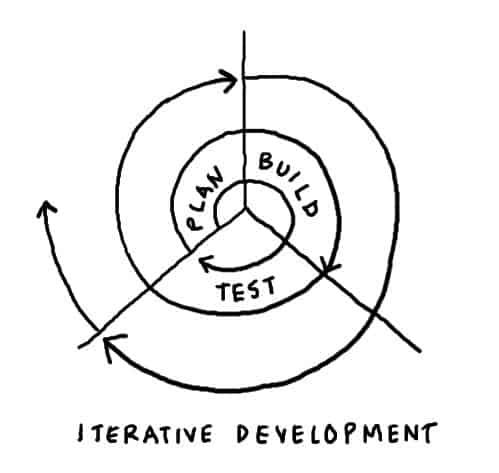MODIFIED ON: November 29, 2022 / ALIGNMINDS TECHNOLOGIES / 0 COMMENTS

Having worked in various organizations for many years in the area of Software Testing, I could firmly say that an Agile based testing approach is becoming a critical factor in bringing superior quality to today’s web and mobile applications.

Agile testing process by Ayal Shimoni
Though there are several testing approaches available, it is high time to come out of traditional approaches and adopt more rigorous and iterative testing practices that make testing more real and bring more effective results.
Agile testing is becoming very crucial while delivering quality results to the customer. I thought I will share with you some basic principles if followed that can bring drastic value additions to your test approach and make your client happy.
Agile Testing: Top 10 principles
Deliver value to the customer
Ensure that each prototype delivered to customer meet their expectation. Example: Is the layout of the website as expected by the customer, are the messages meaningful and user-friendly, does the click on button work, are there any broken pages etc.
Enable face-to-face communication
Direct communication with the client is very important to get a clear picture of the requirements. There might not be proper documents for the change requests as change occurs in a rapid manner in agile environment, however, if a representative from each team (developer, tester, program manager) meet together on a regular basis to discuss the amount of work done, it can help measure the work progress, determine bug status (how many severe bugs still exist, how many were re-opened etc.) and where we stand when compared to customer needs.
Keep it simple
Make a note of changes happening. Organized documents might not be available for every change that comes from the customer, but if you have a record of all changes (with date and comments) preserved at a commonplace, it will help you refer in future in case any confusions arise.
Also, when you report issues to the developer via bug tracking tool (or any other means like a simple spreadsheet), give a precise description of the issue that gives clear idea about the issue, if possible always attach a screenshot as the saying goes “A picture is better than 1000 words”.
Keep a big picture in mind
Although in agile testing methods, prototypes are delivered in short intervals, testers must not get distracted from the big picture of the overall product. Continuous change in code and implementation can sidetrack you from the original requirement of the client. Ensure that rigorous code change does not alter the output from the original agenda.
Provide continuous feedback
Testers must be proactive enough to provide timely feedback to developers and program managers about the quality (bugs founds, requirement missing etc.) of each prototype being delivered to client as each prototype is developed in short time spans and the early the feedback, the sooner the developers can fix those bugs, thus, ensuring delivery of quality product to the client. Focus more on people – make sure all teams (including developers, program managers, and testers) and the customer has the same understanding about a requirement.
Have courage
Sometimes a customer might not have an exact idea of what fits best for his/her requirement. Asking questions and offering ideas can help them choose the best fit for their requirement. Also, it gives you better insight into customer expectations.
Sometimes implementation must be questioned as it might not be the exact way customer is expecting. So, dare to question implementation and the way in which system is behaving as a developer who has developed that piece of the product might not have enough understanding about the requirement and your question can help them build the right piece of product.
It might create friction among teams as you cross-question their code; however, a friendly approach and the right attitude can lead to a fruitful discussion to build a product that fulfils customer needs. Ensure that your team is not intimidated by developers.

Picture by Dave Gray on Flickr
Practice continuous improvement
Always strive to improve your testing skills. Evaluate your testing skills at each delivery. How closely you tested customer requirements?
Were any of the areas left out while testing?
Did customer raise issues that you missed while testing?
Learn from your past experience, make a note of mistakes happened, list out how testing could have been improved at your side and try to implement new steps in your next project.
Respond to change
Change is a constant part of agile testing. Requirements change continuously, code change continuously. If you are having difficulty in keeping track of changes, make a practice of writing down each change (with date and comments that will help you remember why the changes were made etc.). Sometimes this kind of documentation is also helpful to other teams while re-visiting requirements or you can also show it to the customer when they say your product does not match their requirements.
Self-organize
Plan beforehand how your day is going to be. Be prepared to handle an unexpected situation. In an agile environment, there will be constant changes; so, keep a note of what tasks are to be tested on a daily basis and on what priority.
Keeping your work organized and a planned approach to handle your testing tasks can help you to test better and finish tasks in a more efficient and productive way.
Enjoy your work
Knowingly or unknowingly you are doing a very responsible part of bringing the world to a better place, so take this responsibility with great enthusiasm and passion. It gives a great sense of satisfaction to see the product you tested is the built-in right way that makes your customer happy, thus, bringing joyous results to your hard work.
Leave a reply
Your email address will not be published.
-
Recent Posts
- Unveiling the Future: The Role of AI in Spearheading Digital Transformation in 2024
- Chatbots vs. Conversational AI: Decoding the Mysteries Behind the Tech
- Leading the Pack: The Top Conversational AI Platforms Transforming Communication in 2024
- The Future of Work: Key Remote Staffing Trends Dominating 2024
- The Ultimate Guide to Choosing the Right Generative AI Company
-
Categories
- MVP Development (3)
- AlignMinds (55)
- Operating Systems (2)
- Android POS (3)
- Application Hosting (1)
- Artificial Intelligence (19)
- Big Data (2)
- Blockchain (1)
- Cloud Application Development (7)
- Software Development (30)
- Software Testing (9)
- Strategy & User Experience Design (4)
- Web Application Development (23)
- Cyber Security (6)
- Outsourcing (7)
- Programming Languages (3)
- DevOps (5)
- Software Designing (6)
- How to Code (4)
- Internet of Things (1)
- Machine Learning (2)
- Mobile App Marketing (4)
- Mobile Application Development (18)
- Mobile Applications (5)







